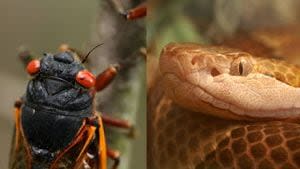Freaky bugs and venomous snakes: Why you may see more copperheads during ‘cicada-geddon’

People across parts of Georgia are already hearing the unmistakable sound that comes with the warmer weather: cicadas.
Parts of the U.S. are going through a unique time this spring and summer as two different broods of cicadas are emerging at the same time.
The 13-year brood, also known as the Great Southern brood, will emerge for the first time since 2011. It’s the largest brood and it stretches across the Southern United States, including here in Georgia.
But the alien-looking bugs may be bringing more than just noise to your back year. You may need to keep a watchful eye for copperhead snakes.
“They’re going to go to those places where the cicadas are available. So they’re a little bit more visible, they’re going to be around the base of trees a little bit more than they normally would be,” Chris Goforth with Citizen Science, told our sister station WSOC-TV.
Goforth said the predators are more likely to be seen while cicadas are out at night.
“The cicadas are crawling out under plants and up trees at night. And so the copperheads and things are out at the same time,” Goforth said.
RELATED STORIES:
Cicadas have become so noisy in part of South Carolina that people are calling the police
Cicadas are coming soon. University of North Georgia professor explains what to expect
‘Cicada-geddon’: Largest cicada invasion in centuries expected over next month in parts of US
Cicadas are helpful to the ecosystem. They provide a good food source for many animals from insects to small mammals, even fish.
“So literally a single person’s backyard could have hundreds of thousands of them so then if you extend that to the eastern US, the numbers are just - like even Georgia might have billions by itself,” University of North Georgia biology professor Evan Lampert said.
“Copperheads eat cicadas the same reason we eat fast food. It’s really cheap and quick,” said David Hutto, herpetologist keeper at Zoo Knoxville in Tennessee, told WATE-TV.
Hutto said copperheads will only eat them when the cicadas have the perfect consistency for them to snack on. He said that’s right after the cicadas pop out of their molten nymph exoskeleton.
“They’ve got to hang on the tree for a little while, while their bodies harden and their wings fill out, and that makes them really, really easy prey for copperheads,” Hutto said.
Copperheads can be found throughout Georgia, “with the exception of the southeastern corner,” the Georgia Department of Natural Resources said.
“They are most commonly seen in forested areas, particularly mixed hardwoods, but tend to shy away from open areas. Areas with rocks or rock piles are favored as well, and copperheads may occasionally be found in lowland riverine or swamp areas,” the DNR said.
Though the snakes are venomous, they generally have mild venom and are usually not deadly. DNR said the younger the copperhead, the more venomous they are.
RELATED NEWS:
